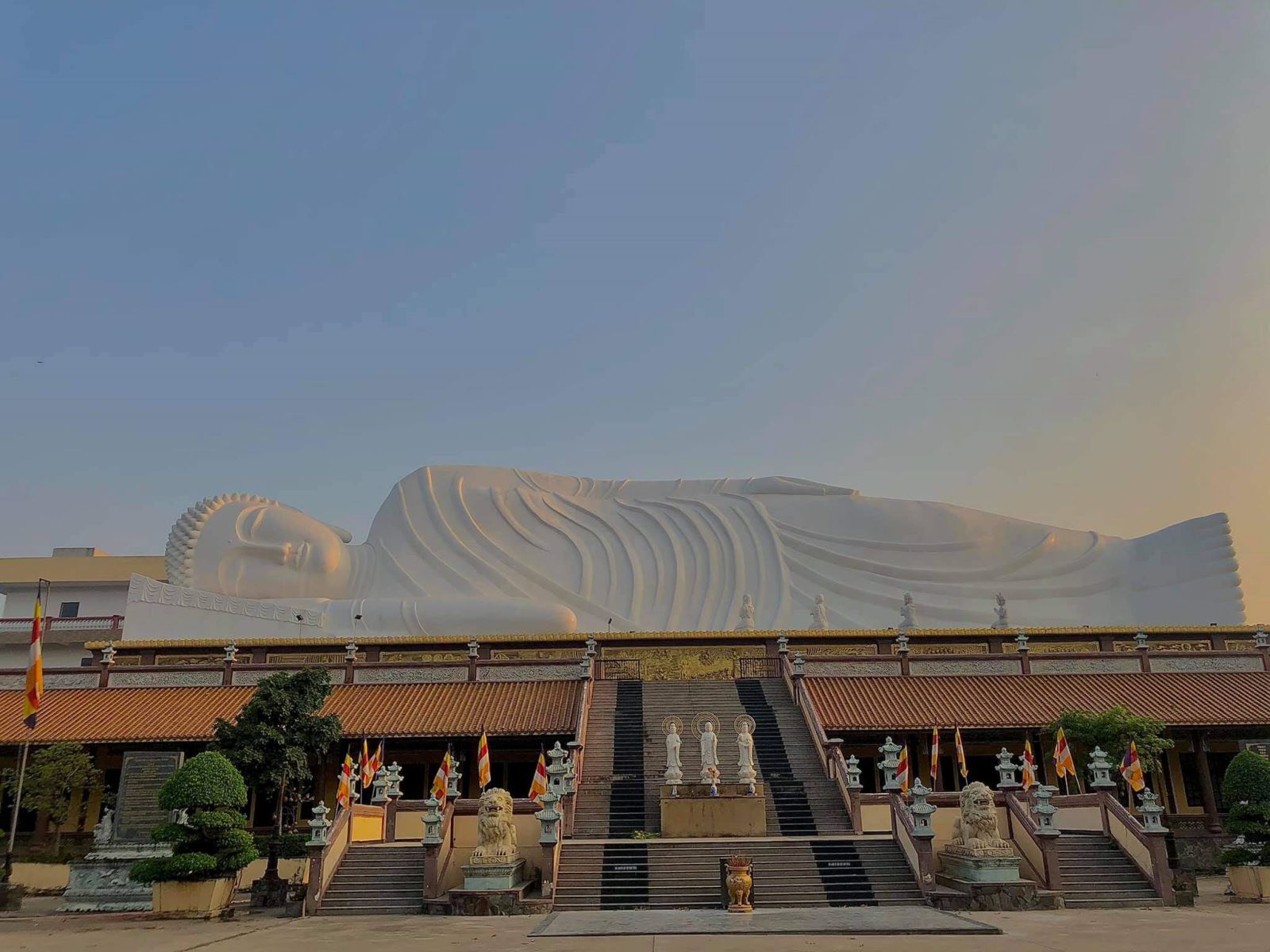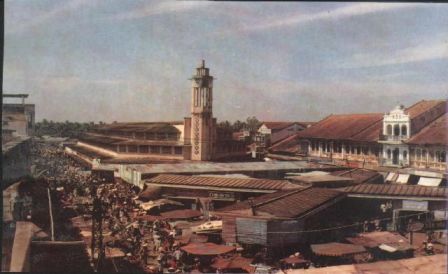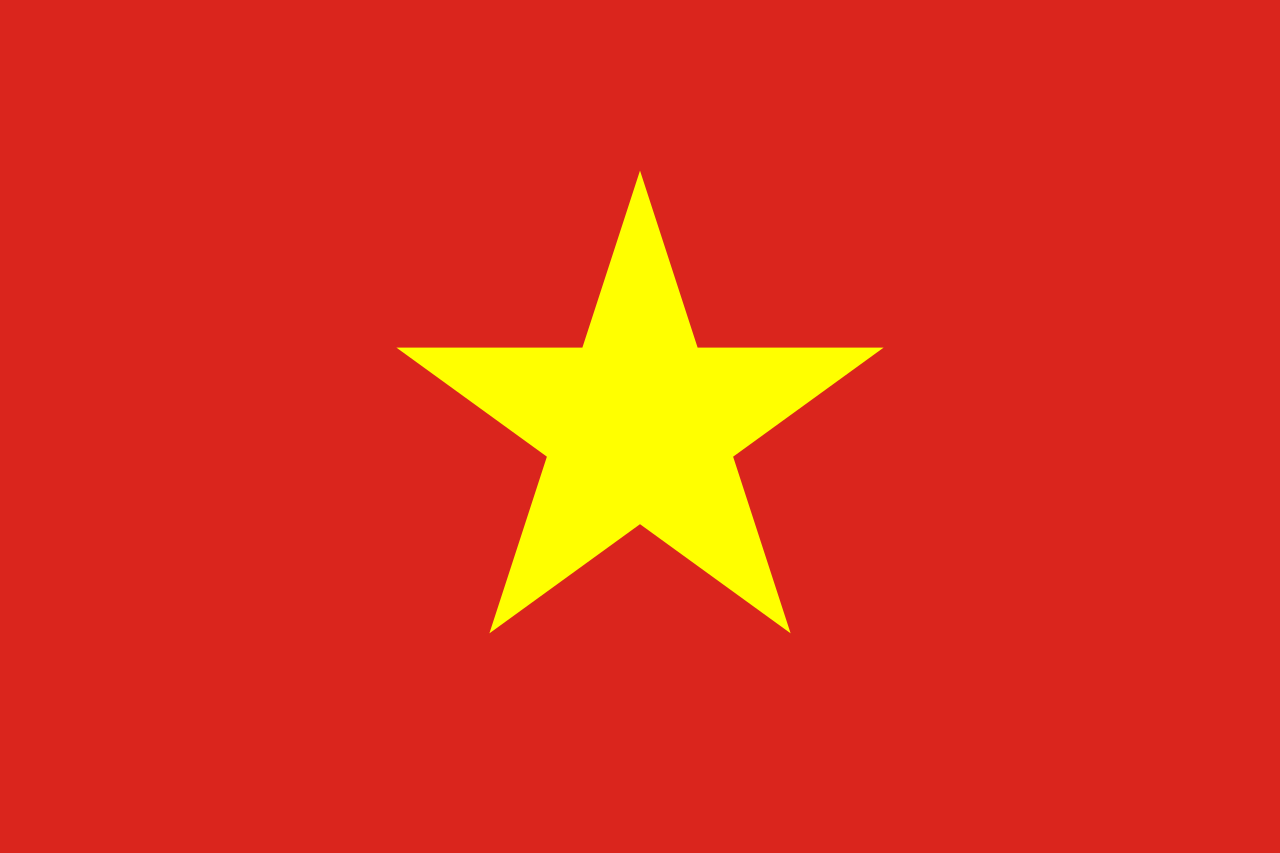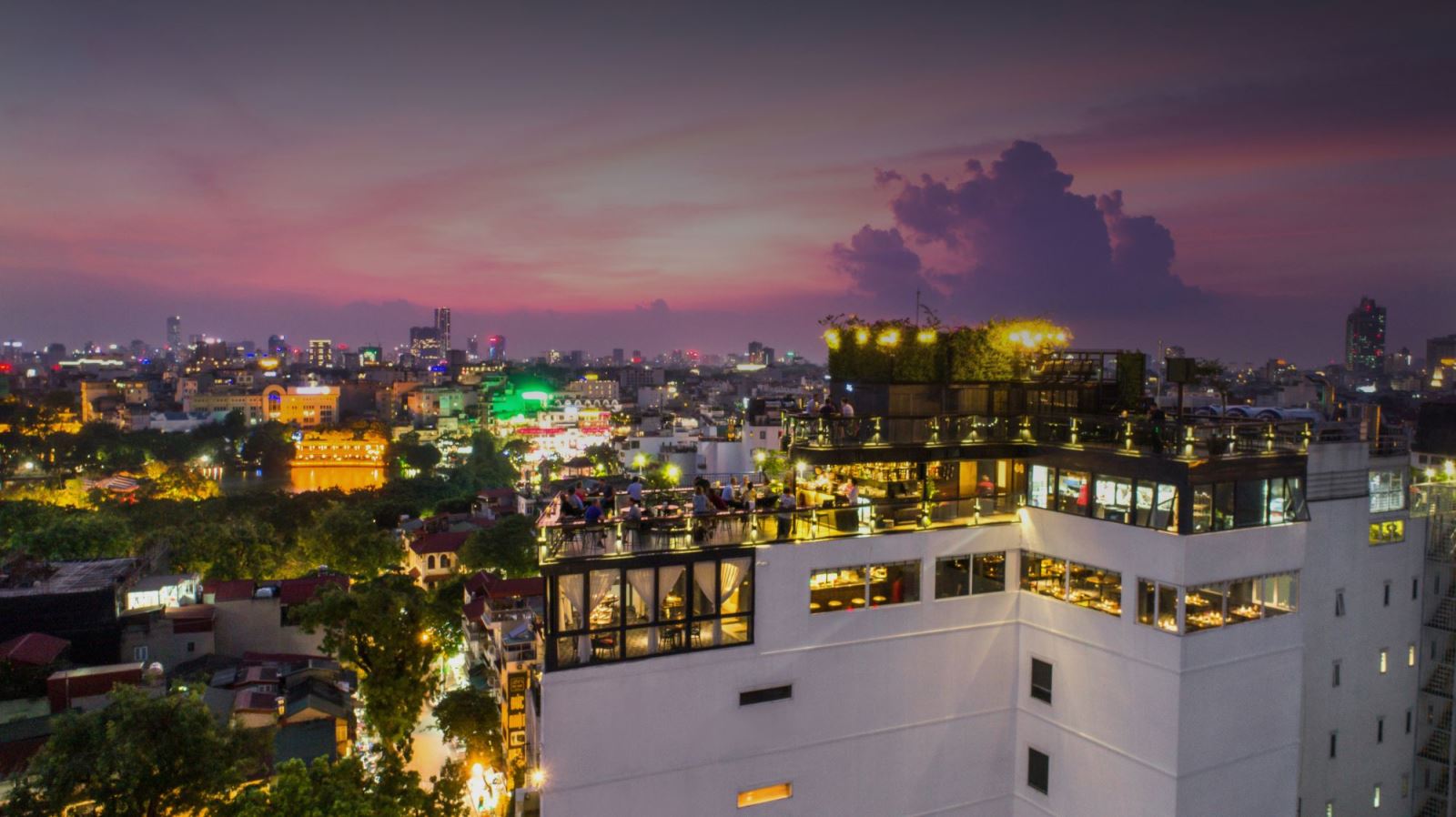
Overview of Thu Dau Mot City
- Administrator
- 4/27/2023
Thu Dau Mot city is a city directly under Binh Duong province, located in the southern key economic region, with a relatively convenient location for exchanges with districts and towns in the province and the whole country via National Highway 13. 30 km from Ho Chi Minh City.
Scenic Landscapes
Hoi Khanh Pagoda is located at the foot of the hill, 500m east of Thu Dau Mot town center, 35 Doctor Yersin Street, Phu Cuong Ward, Thu Dau Mot Town, is a religious and artistic architectural work. The province's largest art museum, was recognized as a national historical and cultural relic on January 7, 1993.
The pagoda was built in the 18th century (1741), and in 1861 the pagoda was destroyed by the French invaders. In 1868, the pagoda was rebuilt in the present position with a construction area of 1,211m2. In 2007, the pagoda built an additional 7-storey tower 27 meters high and recreated the "Four Moves of Mind" Buddha image, including: Lumbini Garden (where Buddha was born), Bodhi Dai Trang (where Buddha practiced religion), Deer Garden (where the Buddha first preached), Ta La Song Tho (Buddha entered nirvana) have profound meanings about the Dharma.
In 2008, a large-scale Buddha platform, 22m high, was built on the land in front of the temple.
The ground floor is a row of houses with a length of 64m, a width of 23m used as a Buddhist School, a Library. The upper floor houses a statue of the great Buddha Shakyamuni entering Nirvana, 12m high and 52m long. This is a proud art work of Buddhism in Binh Duong, solemnly inaugurated on the full moon day of February in the year of the Tiger (March 30, 2010) to celebrate 1,000 years of Thang Long - Hanoi.
Long-standing religious and artistic architectural works
Although it has been repaired and restored many times, it is basically a rare temple that still retains most of the original architecture. The highlight of this ancient temple is its rich value in terms of cultural history, architectural art, especially most of the relics and antiquities that have been preserved for hundreds of years and kept until now. Hoi Khanh is also considered a typical temple for the common characteristics of Binh Duong ancient temples

Hoi Khanh Pagoda
Regarding the structure of the pagoda, there are four main parts: the main hall - the main hall; this architectural amphitheater has 92 precious wooden columns; The East Lang and West Lang pagodas are arranged in a "coupled" style connected to each other with the architecture of "same shelf, same salary". This is a special variation in the architecture of the ancient temple tradition of Cochinchina. The main hall with trusses, wooden walls and three sets of curtain doors, also has nearly 100 wooden statues, Arhat and Minh Vuong crosses with different looks made of jackfruit wood painted with yellow steel. Especially, there are two bas-reliefs carved with 18 Arhats and bodhisattvas, creating a beautiful sculpture with high artistic value, characterized by the ancient Binh Duong wood carving style. This is a work imprinted with the unique talented hands of the artisans of Thu (TDM) at the end of the 19th century (including workers such as alum, sugar, Truong Van Cang, Nguyen Van Ba, Nguyen Van). Xu, Sau Rong, Chinh Tri...).
As for the relationship, poetry and literature are still rich and valuable, which is difficult for any temple to match. In the main hall, there are dialogues representing the Zen religion that many people mention:
“The real weakness of the architecture creates a motionless world
Market does not show color and moon through the sea to mercury and mercury"
(As real as bad, the shadow of bamboo sweeps the floor, the dust on the ceiling does not move.
Is emptiness is form, moonlight swirls the sea, sea water is not stuffed)
In addition, many people also mentioned the couplets of the vice-president Nguyen Sinh Sac
kept at Hoi Khanh Pagoda, with the connotative meaning of Zen learning: "Great Way to open the world to Khue Dam to the moon. Zen subject of education, qui Mao lizard head maple tree" (Translation: expanding the religion as big as a rabbit's horn like finding the moon at the bottom of the water. Nurturing the temple roof like a turtle's hair like a pillar of wind).
As for the art of interior decoration, the worshiping images are very elaborately sculpted and carved, especially in the set of "the Arhat bowls" (artifact 1921). bas-reliefs of "four times" are attached to the two columns in front of the main hall; elaborately carved altars were completed in the year of the Ox (1925). The pagoda still retains the woodblock prints printed on sutras more than 120 years ago
The pagoda's general rose was cast in the year of Qui Mui (1883) and donated by the deity Duong Van Lua. That shows that Buddhism has developed quite early and quite strong in this locality.
Newly built Buddha tower and the largest statue of Buddha entering Nirvana in Vietnam
The attachment between the Dharma and the nation
Since its establishment, the pagoda has experienced 10 abbots (9 have passed away) in which many high-ranking and morally talented monks are famous throughout the South.
In the years 1923 -1926, Hoi Khanh Thu Dau Mot Pagoda was also a refuge for dignitaries: Confucianists, patriotic monks, and established the "Honorary Society" with the participation of Venerable Tu Van himself. Vice President Nguyen Sinh Sac (Father of Uncle Ho), Mr. Tu Cuc... the purpose of the Association is to promote a lifestyle that upholds morality, respects honor and loves the country's compatriots. Although the Association was only active for a short time, it made a significant impact.
After the August Revolution in 1945, Hoi Khanh Pagoda was the headquarters of the Buddhist Association for National Salvation in Thu Dau Mot Province, which had contributed a lot of hard work, including the blood and bones of the monks and Buddhists of the pagoda. During the resistance war against foreign invaders of the local people from 1953, the pagoda was the headquarters of patriotic Buddhism in Binh Duong province and in 1983, Hoi Khanh pagoda was the headquarters of the Binh Duong Buddhist Association. In 1995, here, the Provincial Association built the Basic School of Buddhism in Song Be Province (Binh Duong). Currently, Venerable Thich Hue Thong is the abbot of Hoi Khanh Pagoda (since 1988) and is the permanent deputy of the Binh Duong Dharma Association. Currently, Thu Dau Mot market is located on a relatively flat location, close to the Saigon River and the roads surrounding the market; It borders on Nguyen Thai Hoc Street to the North, Bach Dang Street to the South, Doan Tran Nghiep Street to the West, Tran Hung Dao Street to the East. The market is a center with a convenient location for exchange and trade.
Phu Cuong - the original name of Thu Dau Mot market
Thu Dau Mot Market, in the beginning was called Phu Cuong market. According to local history, the land of Phu Cuong until the beginning of the 17th century was still a wasteland, the landscape here is dense forests. In particular, the outstanding image is the ancient Dau forests in the current Chanh Nghia area, especially the riverside at that time, which were only swamps and flooded gradually formed by the alluvium of the Saigon River. To the south of Phu Cuong with tiled roofs submerged in green foliage. The small canal is covered with sailboats, the market is located at the first canal. When Nguyen Huu Kinh entered the Gia Dinh economic zone in 1698. Today's Phu Cuong area, residents converged somewhat later than Lai Thieu and Thi Tinh, but concentrated more and faster due to the location of the capital. of the canton of Binh Dien, Binh An district of Bien Hoa province at that time.
The place name Phu Cuong appeared around 1838 (the 18th Dynasty of King Minh Menh) along with many changes in the names of cantons and villages of Binh An district. Therefore, the name Phu Cuong market can also be embryonic during this time. Phu Cuong market, historically formed later than some markets of Binh An district such as Tan Hoa market, Thi Tinh market, Binh Nham Thuong market.
The "Thi Diem" (Cho Quan) section of Dai Nam Nhat Thong Chi book - a geographical book compiled between 1864 -1875, mentioned the name of Phu Cuong market: "Phu Cuong market in Phu Cuong village, Binh An district, colloquially known as Thu Dau Miet (or Dau Mot) market in the district capital, is crowded with boats and boats. By 1889, in Binh An district, Thu Dau Mot province was established, Phu Cuong market became Thu Dau Mot provincial market. Since then, the name of Thu or Thu Dau Mot market has been mentioned many times in folklore and in poetry and books.
"In the afternoon, borrow Mr. Do's horse"
Borrowing three soldiers to bring my aunt home
Bringing to Thu market to sell noodle soup,
Selling tea sets and selling pepper mortars.”
Before the French invaded Thu Dau Mot garrison in 1861, Phu Cuong market was a busy trading place, many cars and boats gathered to exchange and trade goods.
.jpg)
The wharf of Thu Dau Mot fish market in 1950
Thu Dau Mot Market - French architecture heavy on European motifs
After the French occupied Cochinchina the six provinces. In which, there is Bien Hoa province (Binh An district of Bien Hoa province), the French have restored and completely transformed Duong market.
Phu Cuong with paved gate and high road inside. According to "local chi Binh wrote in 1888, the French authorities filled the Phu Cuong canal connecting with the Saigon River and completed this work in 1890.
By 1935, the French realized that investing in the market was very profitable, they restored and completely transformed Phu Cuong market to imitate the old markets in France with a structure similar to Nam Vang market. Cambodia) and Ben Thanh market (Saigon). A special feature of the above model is that they still respect and maintain the old position. In 1938, Thu market was inaugurated with a new model, liberal and elegant architecture, at that time and had advantages over many other places.

Thu Dau Mot Market before 1975
The market is divided into seven large and small areas and is built in a rectangular shape consisting of three separate houses. From Tran Hung Dao street, we come across a one-story, one-ground floor house, also known as the (Shopping Area), built and arranged into small subdivisions commonly known as "market stalls" to sale of goods. Behind the Trade Center is a horizontal house (dining area), built between the Trade Center and the Clock area, arranged into three main compartments for dining. Behind is a long house – a row house (or Dong Ho market) which is also built and arranged in small subdivisions even at the foot of the market clock tower.
The market house was the first one built by the French colonialists in 1935, with a ship-shaped architecture, the top of which is a clock with a European motif, designed by French architect Mr. Bonnemain and inaugurated in 1938. The row of houses was built according to the long house architecture, with an area of 2,590m2, with two roofs divided into two floors, the height from the base to the top is 10.3m. The house has a very important meaning in the formation and development of Thu market.>The market clock tower was built in a hexagonal shape attached to the market house, with a height of 23.72m, including four floors. The ground floor from ground to ceiling has a height of 6.5m, which is poured with concrete, reinforced steel, has iron stairs and is mounted on the inside of the tower. In addition to stone paving and cement tiles on the east and west sides of the tower. From the second floor upwards, the tower is built high inside into eight pillars at hexagonal edges. The tower is built in the style of three levels, the higher it goes, the narrower it gets. Up to the third floor, the tower was poured with concrete slabs and built about one meter high to serve as a base for the clock face and also a place to mount the Clock. On the background of the dial is made of white, the numbers are blue and the hands are painted black. On the clock are poured four concrete knitting panels mounted above the clock to block the sun and rain. At the top of the tower are mounted 4 clocks. It is from the clocks arranged according to East - West - South - North that have created a special mark, forming the deep and forgotten feelings of the people of Binh Duong. >The image of the clock tower is the heartbeat of the heart and a symbol that has experienced many ups and downs in the history of this land's formation and development. Thu Dau Mot Market has always kept its position as a typical commercial center of Binh Duong, and also witnessed many important historical events in the struggle for national liberation. Therefore, Binh Duong market is not only a place to buy and sell but also a cultural symbol associated with the development history of Binh Duong and the South.




